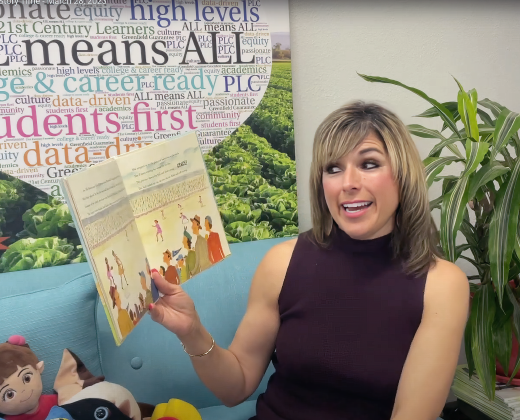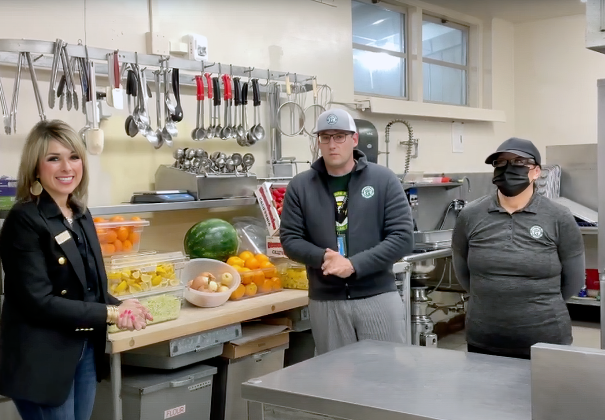Personal branding is all about walking the talk.
As a school leader, you have thought about school branding—but have you thought about personal branding?

If you were to ask your students what personal branding means, they might say something about being an influencer on TikTok or having thousands of followers on YouTube. They might tell you it’s all about content and hashtags and retweets, about joining the online conversation in a way that sets you apart.
And while your students may have good advice, if you’re thinking about your personal brand as a superintendent, your goal isn’t to become the kind of influencer your students follow online. Your goal is to influence your community, to establish yourself as a trustworthy and relatable leader.
If it’s built around your core values, your personal brand can act as a guidepost for your leadership, as an internal locus of control. By reflecting on the kind of leader you are and want to be, you’re giving your community the opportunity to know the real you. And just as importantly, you’re also giving yourself the opportunity to say what you stand for—and then stand for it.
Do you have a brand?
Here at SchoolCEO, we’ve done a good amount of research and writing on school branding. And, as a school leader in this day and age, you’re probably thinking about school branding, too.
School branding can be understood simply as your district's overall reputation: the way people think and feel about your schools. It’s the story they tell. The important thing to realize is that even if your district hasn’t built its brand intentionally, there is still a story circulating about what it means to attend your schools. It just may not be the story you want. As a school leader, part of your job is to guide the narrative so that your community has the right idea about your district.
That exact same sentiment applies to your personal brand. Tara Thompson, chief communications officer at Oklahoma’s Broken Arrow Public Schools, says, “Like it or not, everybody has a brand. They just may not be aware of that brand.” And Zandra Jo Galván, superintendent of California’s Greenfield USD, would agree. “Everyone has a brand,” Galván says. “The question is: Is their brand intentional? Or are they allowing their brand to be created for them?”
Whether you’ve constructed it intentionally or not, there is a story out there about who you are as a leader. Maybe that story is a good one—but maybe it isn’t. Your personal brand is how you control the narrative. It’s how you write the story of who you are.
Building a Personal Brand
Even if your personal brand isn't something you’ve thought about before, it’s never a bad idea to reflect carefully on who you are as a leader and ensure that your community’s perceptions of you are matching up with how you perceive yourself. Below, we’ll look at some ideas for building a personal brand that will establish you as an authentic leader and move both you and your district closer to your unique goals.
Identify—then share—your values.
Galván says her personal brand keeps her grounded as a decision-maker because it keeps her connected to her core values. “When you’re intentional about building a brand,” she tells us, “you have to really think about your core values. Ask yourself: What am I all about? What am I known for?”
Recently, Broken Arrow Public Schools hired a new superintendent. In her role as chief communications officer, Thompson developed a communications plan specifically for the new super, part of which had to do with managing his personal brand. “One of my first questions to him was about his core values,” Thompson tells SchoolCEO. “I asked him to give me two or three things that are really important to him. He chose authenticity, relationships, and roots—so that’s what we built his brand around.”
More than likely, you already have a clear idea of what your core values are as a leader—but the trick isn’t simply to identify what you value. More often than not, values are slippery, nebulous things. The idea is to find ways to live your values and share them with your community.
For Thompson and her superintendent, communicating these values meant making an unusual decision. Every other week, Broken Arrow staff members receive a video from the superintendent as part of the district’s internal communications strategy. But Thompson and her new super decided to keep the videos a little rough, to not over-edit them. Because one of the super’s values is authenticity, they didn’t want the videos to be overly polished. The point wasn’t to create a perfect image; it was to show him as his most authentic self.
Another way to share your values with your community is to weave them into the way you talk about yourself. “We talk a lot about roots,” Thompson says. “Our superintendent went to school here; he taught here; his roots are here. We don’t necessarily make that the highlight of the story all the time, but we do constantly have little throwbacks. We’ll say things like: Hey, he’s walked in your shoes as a student or as a teacher.” Once you know what your values are, find ways to link those values to the stories you tell about yourself—and the stories your community tells about you.
Consider using social media.
It goes without saying that one great way to share your story—your personal brand—with your community is by engaging with online platforms. And while using social media to build your personal brand may sound intimidating at first, just think back to those core values you identified. These aren’t just your core values—they’re your lodestar guiding you forward. For Galván, her three guiding values are kindness, community building, and celebrating kids. She says that, for her, these translated easily to social media.
Take, for example, Galván’s “Superintendent Storytime.” As an elementary school district, Greenfield has a large number of younger students—and Galván has taken it upon herself to ensure they all have someone to read to them at night. “You just use whatever social media platform you have to send out a video of yourself reading a story around the time most of your students would be going to bed,” Galván explains.

She tells us it’s easy to set aside an hour each Monday to make the recordings; then, her team schedules the videos to go out ahead of time using Greenfield’s YouTube channel. “It’s a way to show that you’re a real person,” Galván says. “It’s a way to show you care.” Making sure every one of her students has a positive connection with someone in their school community is important. Reading a bedtime story is part of how Galván communicates to her students that they all are special and deserve kindness.
Galván and her team also do something they call “60 Seconds in GUSD.” “A 60-second segment is anything you want to highlight in your district,” she tells us. “We get an iPad, put it on a tripod, and I ask someone in the district some kind of opening question.” GUSD’s 60-second segments have highlighted everything from a preschool staff member discussing the importance of socialization and play to a cafeteria worker talking about a traditional Mexican dish the students love. By highlighting every aspect of the work happening in GUSD, Galván and her team emphasize the importance of the entire school community.

Regardless of how you decide to engage with your stakeholders online, the key is to be authentic and genuine. The last thing you want to do is create content that drives likes or shares, but that isn’t true to who you are. If social media isn’t the right tool for sharing your authentic self, it probably isn’t the best tool for promoting your personal brand. And that’s okay. If you decide social media isn’t for you, try brainstorming with your team about ways to promote your personal brand offline. What can you say about yourself? Where can you have those conversations?
Let yourself be simplified.
As you begin digging into your personal brand, it may feel like you’re being siloed into a very singular identity. That’s because, in a way, you are. Think of a favorite actor or musician. What do you know about them? Unless you’re a mega-fan, chances are you know two or three major characteristics about most big names. Creating an encapsulated, easy-to-grasp image can be a useful marketing tactic. When you hand people a simple story to tell, it’s probably the story they’ll remember most.
It may sound counterintuitive at first, but streamlining your public-facing identity can help broaden your network. Giving your community two or three things to know about you makes you easier to connect with. Maybe one thing to know about you is that you’re always trying to spread joy, and part of how you do that is by wearing goofy socks every day. Suddenly, every student and staff member wants to check out your socks and tell you which pair they like the best. Then, over time, you might find these conversations have a tendency to go deeper. You might find new relationships forming.
Galván says it’s all about starting with the basics and expanding from there. She says you pick a few things that become “your way in.” And then, from there, “people know you, and doors open to all the things that are important to you.”
Recognize self-promotion as district promotion.
PJ Caposey, superintendent of Meridian CUSD 223 in Illinois, is a bestselling author, keynote speaker, and consultant. He has a newsletter, an active blog, and an impressive online following. But according to Caposey, these avenues shouldn’t be pursued lightly. “Not all superintendents need to focus on building a personal brand the way that I have,” Caposey says, “but that doesn’t mean they shouldn’t, either.”
Sometimes as educators it can feel uncomfortable—if not downright wrong—to talk about professional self-advancement. After all, it’s the students who are the number-one priority. In most other fields, though, making choices to advance oneself professionally is considered an inherent—even necessary—part of the game. Should it be so different for educators? To be clear, we aren’t advocating for self-advancement to the detriment of your students. Rather, we’re suggesting there’s a way to advance yourself and your students at the same time.
Maybe your district is trying to boost enrollment, pass a bond, recruit new teachers, or improve your overall district reputation. The more you strengthen your image, the more credibility you’ll have in your community when you approach stakeholders about any of these initiatives. When you tell your unique story and strengthen your unique personal brand, it’s not just good for you—it’s good for your district.
During our conversation with Caposey, he posed this question: Is Tesla the best electric car? “By most metrics, no,” he tells us. “By stock price, by performance—no, it’s not. But when you think of electric vehicles, what do you think of? You think of Tesla.” According to Caposey, Tesla is the name that comes to mind first because we all know its CEO: Elon Musk. “Whether you like Elon or not,” Caposey says, “you know him, and you know his company as a result.”
Now, are we saying you should be like Elon Musk? Not at all. Our point is that, as a school leader, your success is intertwined with the success of your district. Often, if you’re promoting yourself, you’re promoting your schools—especially because your personal goals and your district’s goals will frequently overlap.
Take, for example, teacher recruitment. According to our 2023 research study “What Teachers Want,” leadership is one of the top three factors teachers consider when deciding which districts to apply to. That means your personal brand could actually play an important role in filling vacancies.
Caposey says that last year, districts in his county had five open principalships. “And the other four positions combined didn’t get as many applicants as we did,” he tells us. Caposey teaches college courses, attends speaking events, and has been interviewed by This American Life. By putting his name out there, he’s pulling people in—all the way into his district.
Hold yourself accountable.
Being clear about who you are and what you stand for will make it easier for members of your community to disagree with you—but that’s not necessarily a bad thing. If someone is disagreeing with you, that means you took a stance. And when you take the same stance consistently, that’s integrity of belief. Caposey puts it like this: “One of the best things that you could say about me as a leader is that I’m predictable.”
Disagreements can be frustrating and, unfortunately, they’re often unavoidable. “But we can’t hide,” Galván says. “When we hide, people create false stories about us.” The upside? If your personal brand is based on your core values, it will be a little easier to stand your ground in the face of conflict. “I just try to be really true to myself on the things that are important to me,” Galván tells us, “because then I don’t have to fake anything.” And Caposey would agree: “Just tell the truth and say what you believe—then people won’t be able to question who you are.”
At the same time, it’s important to remember that your personal brand is more than talk. “Personal brand is an accountability metric,” Caposey explains. “If I’m out here talking about how I believe in culture, but I’m not behaving that way as a leader—that’s going to be all over the blogosphere. I can’t be a hypocrite.” In other words, don’t say you stand for anything you wouldn’t be willing to stand up for. Because, at the end of the day, your personal brand isn’t just about declaring who you are—it’s about being who you say you are. It’s about walking the talk.
Planting Seeds
Let’s be honest: Most of us will never be the kind of influencers your students follow online. But you do have significant influence in your district, and any moment could be the one that changes a life.
“In education, we’re constantly planting seeds, but we don’t ever know which seed is going to take,” Caposey says. “It’s never the one that I would have expected. That’s the beauty and the pain of education. You have 1,000 moments every day that could change a life, but you don’t know which one will stick. You have to put faith in the belief that you’re making an impact.”
When it comes to changing lives, there’s no clear-cut path, no simple to-do list. The best you can do is think carefully about the kind of leader you want to be—and then be that leader. For Galván, it’s as simple as keeping a promise. “If you make a promise to kids,” she says, “you have to keep it.”
Building your personal brand is a way to make your district a promise. You’re promising to think carefully about the kind of leader your schools deserve and to show up as that leader every day. Your personal brand is how you plant seed after seed, trusting that, eventually, something good will grow.
Originally published as "Walk the Talk" in the Spring 2023 issue of SchoolCEO.
Subscribe below to stay connected with SchoolCEO!


